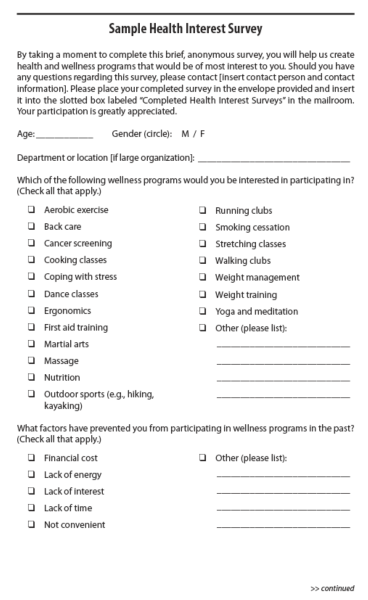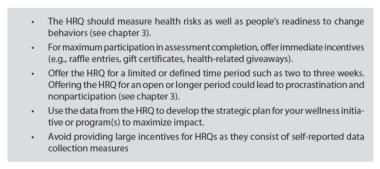Measuring the Success of Wellness Initiatives
This is an excerpt from Winning Health Promotion Strategies by Anne Marie Ludovici-Connolly.
Step 2: Data—Collecting Data or Information
How do I measure the ROI of our wellness initiative? How can I tell if our wellness initiative is cost-effective? How do I know whether the wellness initiative is successful? These are a few of the most frequently asked measurement questions posed by senior leaders of organizations that have invested in or have contemplated the implementation of a wellness initiative. These are very reasonable questions and concerns. Senior leaders want to know how to determine whether their investment in wellness will provide financial returns. The answer lies in the data. To measure ROI, you must begin by collecting baseline data on the population, or the members of your organization, and monitor data measures periodically to assess progress. (This is discussed in more detail in Step 5: Success on page 40.)
To ensure that any investment is profitable, you must first collect baseline data for evaluation. Without collecting baseline data from a variety of related sources, or without taking the time to carefully evaluate that data initially and throughout the course of your wellness initiative, you will not be able to discover whether your initiative is making a positive impact. So, what type of data can you collect to measure the success of your wellness initiative? The following data collection strategies— health interest surveys, health risk surveys or health risk questionnaires, and biometric screenings—provide basic best-practice assessments for a comprehensive wellness initiative.

Health Interest Survey
The Wellness Council of America recommends the distribution of a health interest survey as an effective initial data collection strategy. A simple, short, nonintrusive survey listing potential programs to be offered as part of a comprehensive wellness initiative helps gauge the interest of potential participants. This information can provide very valuable data to use in the development of a targeted strategic plan also. It is important to know what individuals need to improve their health, but knowing what they want will allow you attain the highest level of engagement and participation in your programs.
A sample health and wellness survey is presented on pages 29-30. You may customize or tailor this survey to your organization by adding, deleting, or modifying questions. You may distribute the survey in paper form or post it online for completion at computer workstations. If you want help creating a survey from scratch, the Web site Survey Monkey offers “a revolutionary tool to create and publish custom surveys in minutes, and then view results graphically and in real time” (www.surveymonkey.com/).
A health interest survey is a powerful strategy for introducing a wellness initiative and engaging potential participants. Organizations have reported that people are somewhat suspicious when health risk surveys are used as the first data collection tool in the design of a comprehensive wellness initiative. They may question why the organization is requesting sensitive lifestyle information as well as what they are planning to do with this information. By distributing the health interest survey first, many organizations report that employees express fewer concerns, and that they are more likely to participate in a health risk survey later. By first asking people what they want via the health interest survey, you can then engage them in addressing what they needthrough the results of a health risk survey or questionnaire.


Health Risk Questionnaire (HRQ)
I Took Charge of My Health! This slogan was printed on custom-made stickers given to employees to put on their lapels once they completed their HRQ as part of the launching of a wellness initiative. The purpose of these stickers (which make the program visual, an example of the three Vs) is similar to the I voted stickers people wear after voting to promote others to do the same. The stickers create a buzz by encouraging others in the organization to attend the event, complete the HRQ, and start taking charge of their health!
Administering the HRQ is an essential step in determining the health risk behaviors of a population. A model HRQ asks questions that evaluate health risks as well as people's readiness to change their health behaviors. They are available from most health care providers, state and local public health departments, and private wellness vendors.

The HRQ is typically administered on an annual basis, providing valuable health information on a population over time (i.e., health related trends). It is a key tool for evaluating wellness program outcomes or progress. As such, the HRQ should be a scientifically reliable and validated instrument. Non-technically speaking, a reliable questionnaire is one that would give the same results if you used it repeatedly with the same population or group. For example, a reliable questionnaire will give the same results on Tuesday as it did the previous Monday. A validated questionnaire is one that has been shown to measure what it purports to measure. A reliable and validated HRQ can be used in pre- and post-evaluations of wellness initiatives, as well as in the evaluation of short- and long-term trends over time. A reliable and validated HRQ should be developed by, or in consultation with, someone with expertise in program evaluation or statistics to ensure that the results are meaningful.
The process of simply administering the HRQ may be considered a part of a health intervention because it is designed to raise individual health awareness via self-assessment. The HRQ also provides an organization with valuable information on the health of its population for effective wellness program planning. The administration of the HRQ should always be followed with a wellness program or implementing a health intervention based on the results.
ACSM's Worksite Health Promotion Manual (Cox, 2003, pg. 47) cautions: “Many health promotion practitioners have made the mistake of investing too much of their resources in a HRA (Health Risk Assessment) or HRQ. While an HRQ is a very important component, without the necessary resources for diligent follow-up, program success will not be achieved. A HRA alone will not create behavior change.”
Sample questions on an HRQ may be related to the following:
- Lifestyle behaviors such as diet, exercise, smoking, and seat belt use
- Preventive health care (e.g., annual physical exams, routine checkups)
- Stress and mental illness
- Readiness to change lifestyle behaviors


Biometric Screenings
A man once told a nurse who was providing blood pressure screenings at an on-site biometric screening worksite event, “If I knew my blood pressure was so high, I would have filled the prescription for my blood pressure medication that my physician gave me at my physical six months ago.” These were stunning words from a man whose blood pressure was through the roof! His blood pressure numbers were well over normal values. In fact, they were in such a dangerous range that the nurse requested that the man immediately call his physician, who saw the man in his office that very afternoon. The nurse later stated that if this man had not attended the screening event and seen his physician immediately, there would have been a high probability that he would have had a serious cardiac event. In other words, this screening event may, indeed, have saved his life.
Biometric screening events provide detailed assessments of basic health indicators, including blood pressure, body mass index (calculated from height and weight), cholesterol (HDL and LDL), and blood glucose. Such events are very valuable for creating awareness and providing educational opportunities for participants in worksite, community, and school settings. It is advantageous to offer biometric screenings in conjunction with the HRQ. Participants can then more accurately answer questions on the HRQ versus relying on estimates of their personal health data.

SHOP

Get the latest insights with regular newsletters, plus periodic product information and special insider offers.
JOIN NOW


